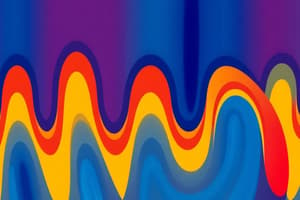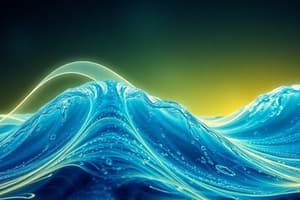Podcast
Questions and Answers
What describes light that only oscillates in one direction?
What describes light that only oscillates in one direction?
- Dispersed
- Refracted
- Polarized (correct)
- Scattered
Which type of lens causes light rays to spread apart?
Which type of lens causes light rays to spread apart?
- Concave (correct)
- Convex
- Neither Convex nor Concave
- Both Convex and Concave
Which of the following is a primary subtractive color?
Which of the following is a primary subtractive color?
- Green
- Cyan (correct)
- White
- Red
What happens to light when it passes through a prism?
What happens to light when it passes through a prism?
Which of the following is NOT a true statement about the human eye?
Which of the following is NOT a true statement about the human eye?
What is the name given to the area where a longitudinal wave is most densely packed?
What is the name given to the area where a longitudinal wave is most densely packed?
Which of the following is NOT a characteristic of mechanical waves?
Which of the following is NOT a characteristic of mechanical waves?
What happens to the energy carried by a wave when it is reflected?
What happens to the energy carried by a wave when it is reflected?
What type of wave is produced when a pebble is dropped into a still pond?
What type of wave is produced when a pebble is dropped into a still pond?
Which of the following is NOT a characteristic of sound waves?
Which of the following is NOT a characteristic of sound waves?
Which of these is NOT an example of a mechanical wave?
Which of these is NOT an example of a mechanical wave?
What is the relationship between the frequency and wavelength of a wave?
What is the relationship between the frequency and wavelength of a wave?
Which of the following is the unit for measuring frequency?
Which of the following is the unit for measuring frequency?
What is the phenomenon that occurs when waves pass through an opening or around an obstacle?
What is the phenomenon that occurs when waves pass through an opening or around an obstacle?
What is the Doppler effect?
What is the Doppler effect?
Which of these is NOT an example of a standing wave?
Which of these is NOT an example of a standing wave?
What is the name of the point of maximum destructive interference in a standing wave?
What is the name of the point of maximum destructive interference in a standing wave?
What is the relationship between the intensity of a sound wave and its loudness?
What is the relationship between the intensity of a sound wave and its loudness?
What is the name of the electromagnetic radiation that humans can see with their eyes?
What is the name of the electromagnetic radiation that humans can see with their eyes?
What is the name of the phenomenon that occurs when light passes from one medium to another?
What is the name of the phenomenon that occurs when light passes from one medium to another?
Which of the following is NOT a characteristic of a concave mirror?
Which of the following is NOT a characteristic of a concave mirror?
Flashcards
Refraction
Refraction
Bending of light when it enters a new medium at an angle.
Concave Lenses
Concave Lenses
Lenses that cause light rays to diverge and produce only virtual images.
Convex Lenses
Convex Lenses
Lenses that cause light rays to converge, producing real and virtual images.
Prisms
Prisms
Signup and view all the flashcards
Additive Primary Colors
Additive Primary Colors
Signup and view all the flashcards
Wave
Wave
Signup and view all the flashcards
Medium
Medium
Signup and view all the flashcards
Mechanical Waves
Mechanical Waves
Signup and view all the flashcards
Electromagnetic Waves
Electromagnetic Waves
Signup and view all the flashcards
Amplitude
Amplitude
Signup and view all the flashcards
Wavelength
Wavelength
Signup and view all the flashcards
Frequency
Frequency
Signup and view all the flashcards
Period
Period
Signup and view all the flashcards
Doppler Effect
Doppler Effect
Signup and view all the flashcards
Interference
Interference
Signup and view all the flashcards
Standing Wave
Standing Wave
Signup and view all the flashcards
Sound Waves
Sound Waves
Signup and view all the flashcards
Electromagnetic Spectrum
Electromagnetic Spectrum
Signup and view all the flashcards
Study Notes
Waves
- Wave: a disturbance carrying energy through matter or space.
- Medium: the matter through which a wave travels.
- All waves are either mechanical or electromagnetic.
- Mechanical waves require a medium to travel, including sound, earthquakes, and tsunamis.
- Electromagnetic waves don't require a medium, consisting of interactions between electric and magnetic fields.
- Energy: the ability to do work. Waves carry energy. Bigger waves carry more energy.
- Energy spreads outwards as the wave travels.
- Wave front: each circle of a wave spreading outwards carrying the same energy.
Types of Waves
- Simple Harmonic Motion: a type of vibration where a force moves a mass back and forth to its original position.
- Damped Harmonic Motion: a type of vibration that fades as energy is transferred.
- Transverse Waves: wave motion is perpendicular to the particle motion (e.g., electromagnetic waves).
- Crest: the top of a transverse wave.
- Trough: the bottom of a transverse wave.
- Longitudinal Waves: wave motion is parallel to the particle motion.
- Compression: areas where the wave is crowded.
- Rarefaction: areas where the wave is spread out.
- Surface Waves: waves where particles move both perpendicular and parallel. Occur at the boundary of two different mediums.
- Transverse Waves: wave motion is perpendicular to the particle motion (e.g., electromagnetic waves).
- Amplitude: greatest distance of particles from their normal resting positions. Larger amplitude means more energy.
- Wavelength: distance between wave crests or troughs. Shorter wavelength means more energy.
Wave Properties
- Period: the time required for one complete vibration (T).
- Frequency: the number of wavelengths in a specific time interval. Measured in Hertz (Hz).
- Wave speed: the distance a wave travels in a specific time, equal to wavelength multiplied by frequency.
Wave Interactions
- Reflection: a wave bouncing back when it meets a surface or boundary. Does not change speed or frequency (can flip the wave).
- Diffraction: bending of waves as they pass through an edge of an obstacle or a narrow opening.
- Refraction: bending of waves when they pass from one medium to another, changing speed.
- Interference: combination of two or more waves resulting in a different wave.
- Constructive Interference: waves combine to make larger or louder waves.
- Destructive Interference: waves combine to make smaller or quieter waves.
- Standing waves: a pattern of vibration resulting from interference and reflection of wave.
- Nodes: points of total destructive interference.
- Antinodes: points of total constructive interference.
Sound
- Sound waves are longitudinal mechanical waves.
- Speed of sound depends on the medium and temperature.
- Loudness: response to intensity of sound, measured on the decibel scale.
- Pitch: how low or high a sound is, dependent on frequency.
- Infrasound: frequencies below what humans can hear.
- Ultrasound: frequencies above what humans can hear.
Musical Instruments
- Grouped based on vibrations (strings, wind, membrane).
- Vibrations change wavelength and frequency (pitch).
Resonance
- Phenomenon where two objects naturally vibrate at the same frequency.
Light
- Light has a dual nature: wave and particle (photons).
- Electromagnetic spectrum: all possible light waves, differing frequencies.
- Transparent, Translucent, Opaque: materials allowing or absorbing light.
- Light Rays: imaginary lines showing light direction.
- Law of Reflection: the angle of incidence equals the angle of reflection.
- Regular reflection: light reflecting in one direction off smooth surfaces.
- Diffuse reflection: light reflecting in many directions off rough surfaces.
- Mirrors: reflect light to create images(virtual or real)
- Flat Mirror: upright image same size as object.
- Concave Mirror: can create upright or inverted images that can be bigger or smaller than object.
- Convex Mirror: always creates an upright image smaller than the object.
- Refraction: change in speed when light passes through different materials, causing bending of light rays.
- Polarization: light waves vibrating in only one direction.
- Scattering: light not coming out the same way it went in.
- Lenses: cause light rays to converge or diverge, creating images.
- Concave lenses: spread light rays apart (diverging lenses).
- Convex lenses: bring light rays together (converging lenses).
- Prisms: separate white light into its component colors (spectrum) due to dispersion.
- Color: dependent on the frequency of visible light that reaches our eyes.
- White Light: contains all colors. Black light: absence of color.
Studying That Suits You
Use AI to generate personalized quizzes and flashcards to suit your learning preferences.




